The Danish Chronicles #3: Storming the Castle Gates
Part three of eight in "The Danish Chronicles,“A Danish-American granddaughter rediscovers her family’s forgotten past—from manor house gardens to the atomic lab.”
In October of 1997, when my daughter was 13, we embarked on a four-month adventure of a lifetime. My travel muse overtook me, and I lost all reason. Someone very dear to me was getting married in Germany, and I wanted to go. However, Krystle was having trouble adjusting to the rougher world of public school after being the little darling of her Christian school for seven years, and I didn’t want to leave her. Against the criticism of the community, who didn’t understand my vagabond ways, I took Krystle out of school—along with her curriculum, which I would teach—and we went to Europe for four months, basing out of Bern, Switzerland with our Swiss exchange daughter Rebekah. We then visited other exchange daughters and friends in France, Germany, Luxembourg, Austria, Denmark, Sweden, Norway and Liechtenstein, nine countries in all.
I, as always, kept a detailed journal, and it is one of my most treasured possessions. We had incredible experiences and adventures, but this one is the apex of the trip. Just after Christmas with our exchange daughter Veronika’s family, we hopped the train to meet up with Mia, our exchange daughter from Denmark. The two girls and I would be staying on the island of Fyn in the home of Grethe and her daughter Viebeke, who we also knew from the Youth for Understanding exchange program. They lived in the city of Otterup, which, which a purille part of my brain wants you to know, is only a few miles from Middelfart.
I had sent Grethe, at her request, all of the information I knew about our Danish roots, which was not much at that time. I knew that my people were from the island of Fyn, that my great-grandfather was a castle gardener, his wife, who died early, was from Sweden. But I did have something of great value, documents, including a will—all in old Danish—which even my exchange students couldn’t read. These included photos, “Working Books” for Gartner Hans Hansen and his son Lars Peder, a penmanship workbook from Gartner Hans Hansen's school years, letters, postcards, a poem written by Emilie Gustava Nilsdatter, which places her at a certain place and date in Denmark, gardening journals from Gartner Hans Hansen and passports. We are extremely lucky that these things exist. She thought that, with the copies of those, she might be able to trace my family who was still Denmark.
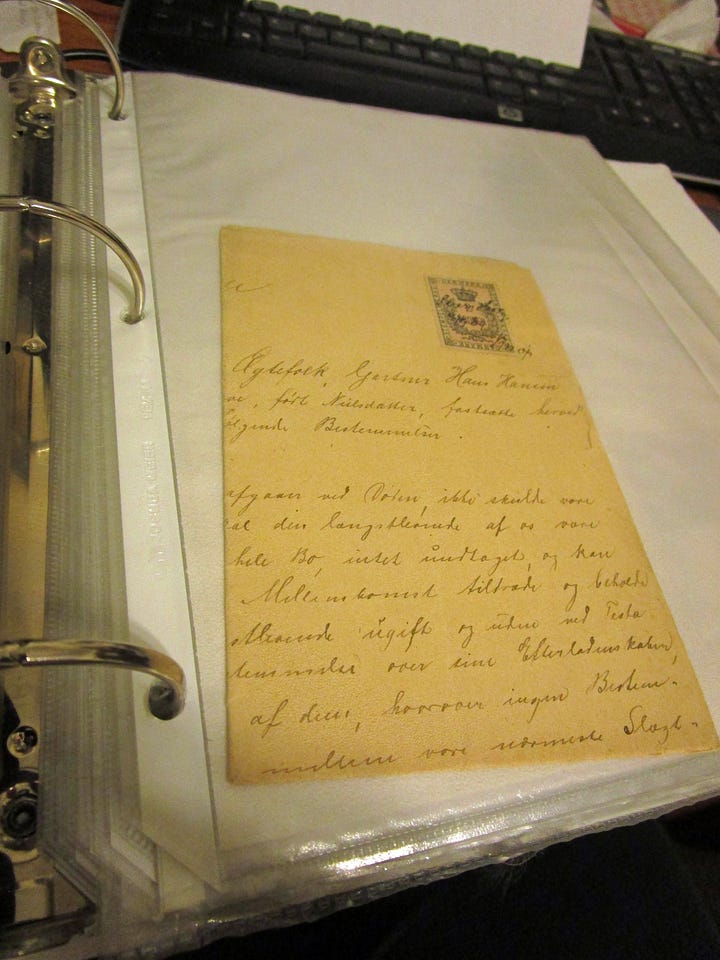
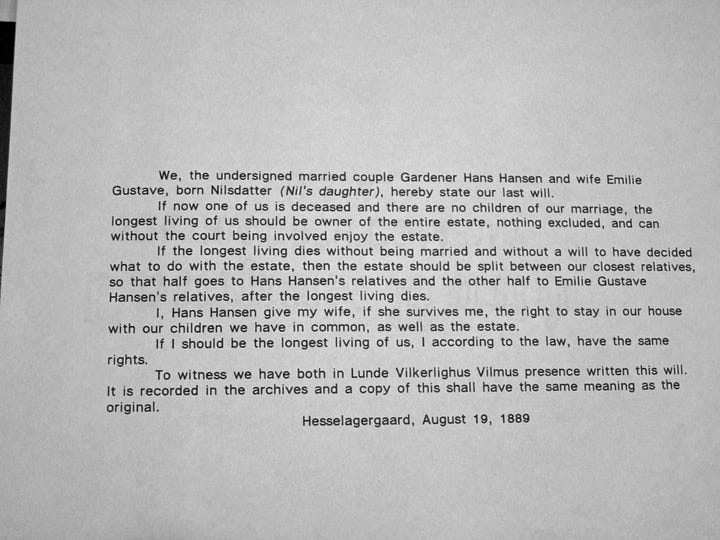
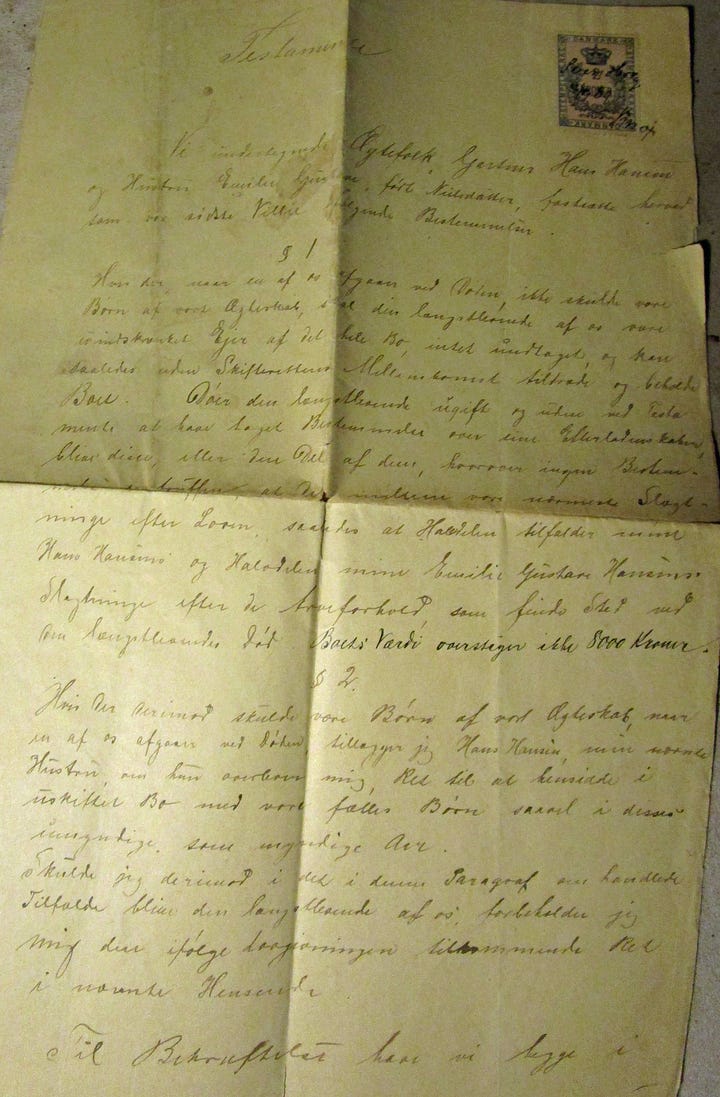
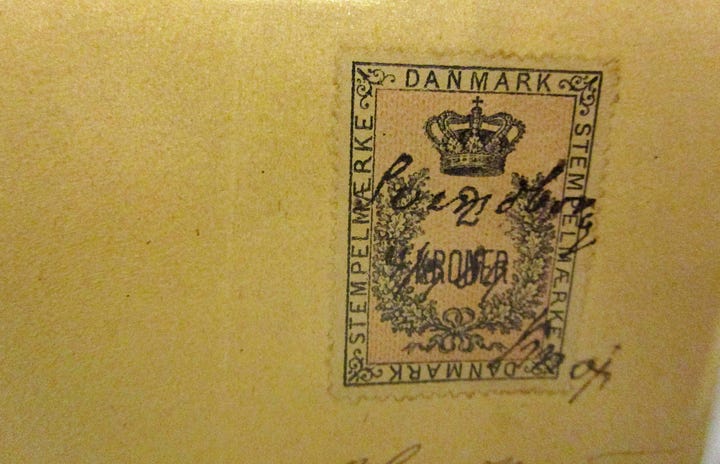
When we arrived, there was a beautiful Danish dinner awaiting us: pork chops, sausages, boiled potatoes, red cabbage, beets, sugar potatoes (tiny new white potatoes boiled and then glazed with sugar and spices) and, for dessert, a special tradition: rice pudding with a hidden whole almond. Whoever finds the almond gets a present. The Christmas in Germany with Veronika’s family had involved five solid days of gluttonous eating. When we left Germany for Denmark, we swore we’d never eat again. We were able to do the meal justice, but I felt daunted by that rice pudding. I love rice in all of its forms. It is, in fact, my favorite food, but I like it in savory applications, never sweet. While my brother would occasional eat it for breakfast with milk and sugar, I ate mine with butter and salt and pepper. Before our trip, I told Krystle this mandate: we must eat everything served us with no complaint. The family was very excited about that almond, so we did our duty and had a nice, big helping of rice pudding. But no almond. More was thrust upon us. The almond must be found! Finally, I turned to Grethe and told her we simply couldn’t eat another bite. I was feeling like I might vomit and Krystle was green around the gills. It was at that point that naughty, naughty Viebeke stuck out her tongue and revealed that she’d been hiding the almond on her tongue since the first serving. I guess this is a common trick. Grethe told of one friend who would bring his own almond and pretend to find it, a strategy I will remember. And what was the present for Viebeke the cheater? Chocolates. She offered to share, but we declined.
While we were sitting there in a stupor, Grethe asked what we’d like to do the next day. I said, “Whatever you have planned is fine.” And then said some incredible, magical words, as if they were words one would say every day: “Would you like to go to church where your great-grandparents got married?” I said, “Sure,” thinking she meant that we’d go to the church in the area where they lived because that might be where they got married. Underwhelmed by my response, she explained that, taking the information I’d given her, she’d found Gardener Hans Hansen and his Swedish wife Emilia Gustava Nilsdotter wedding records and we’d be going to the actual church where they got married on November 2, 1888. I started crying when she showed me the record that gave us several more details about their lives.
The above wedding record for Hans and Emma that Gerthe had discovered places him as a gardener at Hesselagergård, the castle. When facts fit family lore, it is something to be celebrated.
But wait! There’s more. The next thing she asked were with the most incredible words I’d heard in my life: “And, shall we drive by the castle where your great-grandfather was gardener?”
In that moment it was real. All of the legends. All of the lore. They weren’t just stories; they were people. They were my people, and this island was my motherland.
The church service was at 2:00 pm, an unusual hour for Americans. We left early so we could spend some time in the graveyard looking for family graves. That was a big disappointment because it seems that most of the tombstones had the same five names or so on them. There were Hans Hansens everywhere! Of course I knew that my great-grandfather’s grave was in Zillah, Washington, but I hoped to find his brothers or parents.
Grethe and Viebeke, however, were thrilled to find the Blixen-Finecke name. Karen Blixen-Finecke aka Baroness Karen Christentze von Blixen-Finecke, was the author of Out of Africa, played by Meryl Streep in the movie of the same name. They were wondering what the connection to these grave was. Later in the afternoon, we would find out, and the day they planned as a treat and surprise for us, would become as big of a day for them.
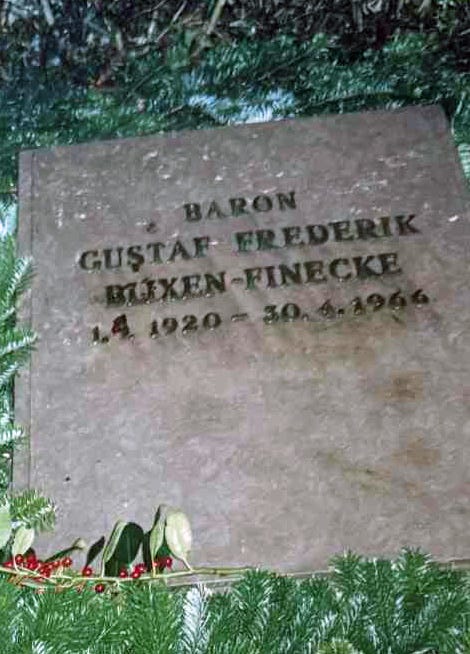
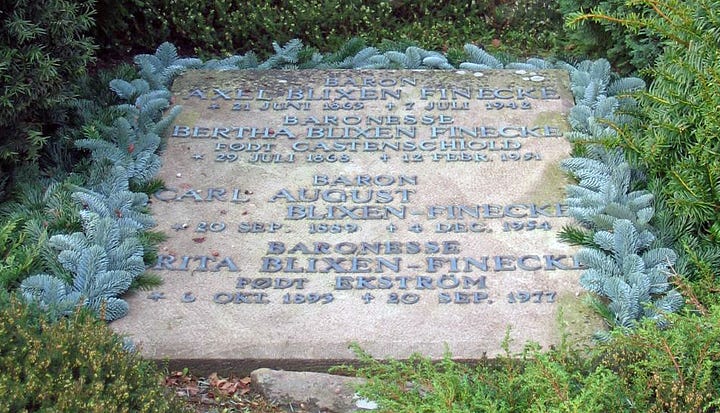
I have gone to church services in many cities in Europe, the this one had the most pitiful attendance with only two congregants other than the five of us. But it was enough for me to to know that I was sitting in the very church where my great-grandparents were married 137 years ago. I sat there and tried to imagine Hans and his Emma, with the church full of family and friends and fellow workers from the castle. Sitting next to me on the pew was a canvas bag I had prepared for our Danish leg of the trip. It contained every Danish picture and document I had. Krystle and I called the bag, “The Fam.” In a flight of whimsy, I could almost imagine the ancestors peeping out from the bag.
After the service, we girded our loins (whatever that means, but it sounds appropriate for a castle visit) and headed for Hesselagergård, just a few miles down the road. Grethe tried to tamp down my fevered excitement with words of warning, “Cynthia, please understand that Hesselagergård is not open to tourists; it is a private manor. We will only be able to see a glimpse of it from the road through the trees.” I acquiesced, just happy to see it in reality.
That is, I acquiesced, until I caught a glimpse of it through the trees from the main road. More! I had to have more! We came upon the small road leading to the castle, the only means of ingress, since the castle was surrounded on three sides by a moat. (Yes! An actual moat! Oh, my glory!) The road wove in and around a beautiful little forest. At the head of the road there was a sign that clearly said, “Privat bolig. Adgang forbudt.” (Private residence. No trespassing)
“Please, Grethe,” I pleaded. “Just drive down close enough for me to get a photo through the trees. It will only be a minute and if we get stopped, I’ll just explain that I’m an American and my great-grandfather worked here. Who knows? Maybe they’ll let us in?” She sighed heavily and turned into the road going about half way when she stopped the car and said, “That’s as far as I go.” I got out of the car and Krystle and Mia joined me. “Hurry!” a very nervous Grethe urged.
I stood there looking at that castle, with a deep longing in my heart that could not be denied. “I’m going in,” I said, resolutely. “Me too!,” said my daughter, whose DNA would never let her do otherwise. “Me too!” shouted Mia, who was always up for adventure.
We went tearing back to the car and I told Grethe, “We’re going in.” She sighed very heavily this time and said sternly, but with compassion, “Cynthia, don’t think for one moment that you’re going into that castle.” I replied with a grin, “Ah! Don’t think for one moment that I’m not.” Turning to Krystle, I said, “Get The Fam,” pointing to the canvas bag, “they’re going with us.” I had come so far and, now that we were so close, I had to see it through.
So, glad of those girded loins, the three of us boldly walked down the road and entered the castle grounds. Europeans, who can view a castle on every hill, know that there are many kinds of castles, from the truly magnificent to an imposing, but smaller manor house. As an American child growing up hearing the word castle, I imagined ramparts, a drawbridge and donjon, crenellations and towers. In reality, Hesselagergård is less Disneyland and more Downton Abbey, a manor house. However, built in 1538 by Johan Friis’ as a display of power, it did have some castlesque features besides the moat, including round towers on the corners.
We didn’t walk as boldly once we got on the grounds and neared the castle. Our hearts were racing and we were feeling timid. What was this crazy thing we were doing? Did we even have a plan? We felt so small next to the looming castle and all the outbuildings, which made it look like a small city.
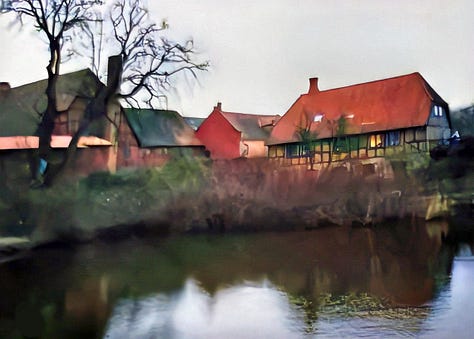
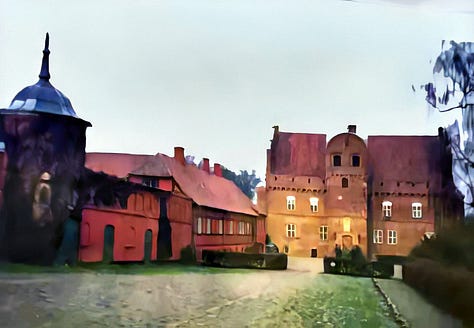
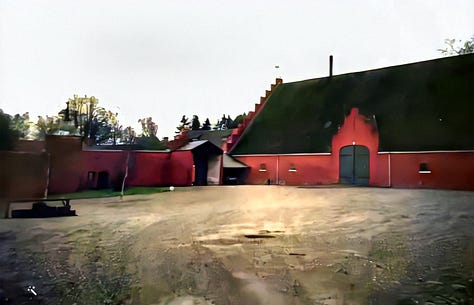
I looked around for beautiful gardens, but they were no more. The garden, in fact, was overgrown, neglected and full of molehills.
I decided that, rather than “getting caught,” we would try to find a person as soon as possible and state our case. I saw a light on in one of the small outbuildings and knocked on the door. A young woman answered and, when I’d told her our mission, she pointed up the hill to the Keeper’s House and told us to go there. We did, but no one was home, so we tried another little house. The young woman there said that the Baron was out of the country in Italy and the rest of them were guests who were staying to to hunt. Since it appeared the little city and the castle were all deserted, we decided just to make ourselves at home and look around. With the Baron out of town, we wondered who would answer the door if we knocked on it. Maybe it would be a maid and she’d give us a tour! All things are possible to us mad dreamers and audacious adventurers. So, feeling like three little Jacks in the Beanstalk, we walked up the steps and knocked on the castle door. Our pounding echoed loudly or what that our hearts?
When no one answered, we decided we had our own castle to play with so we decided on a self-tour of the outer castle and grounds. While I was talking photos of the deplorable condition of the grounds, Mia and Krystle were looking in the bottom windows. Mia called out, “Mom! This kitchen is so cool!” I scolded, “Mia! You’re not looking in the windows, are you? Then I took a picture through the window. We were feeling pretty outrageous by then. Then we saw a man painting an out building and decided to investigate him before he invested us.
He was an old guy who does chores about the place and has been there his whole life. We were very thankful to have Mia with us because he did not speak English, which is unusual for Danes. He said that they no longer keep a garden (yeah duh), but he lived in what was the Gardener’s House when they had their own gardeners. Then Mia told him that my great-grandfather had been the master gardener there in the 1800s, so he let us take a picture of the house. The very house where Hans Hansen took his bride Emma and where their first child Inger was born.
He went on to say that it’s a shame the Baron was away, but that his aunt was home and would love to see us. He directed us to go past a big oak and some horses to a large cottage at the far end of the property. We hurried back to the car, excited to share our news. I blurted, “You doubted me? How would you like to take tea with a Baroness this afternoon?” Turns out, since we had an invitation, they’d like it very much indeed.
Anna Elisabeth (Beth) baronesse von Blixen-Finecke (second husband Thorbjørn Møller), lived on the grounds of Hesselagergård at the estate’s original forester’s residence, known as Villa Skovly. She and her first husband Gustav Frederik baron von Blixen‑Finecke, her first cousin, jointly held ownership of the barony of Hesselagergård until 1963, when she relinquished the title and the barony to enjoy a more private life of her work with mosaics where she was known as simply Fru Møller.
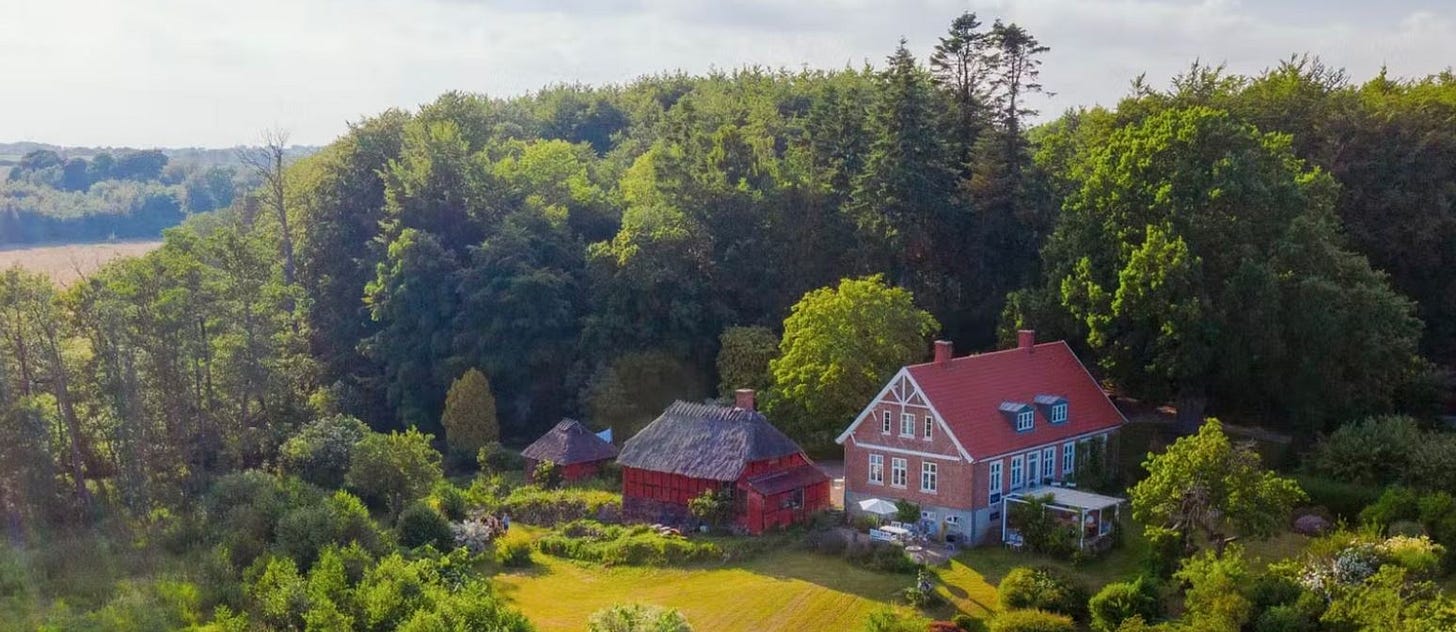
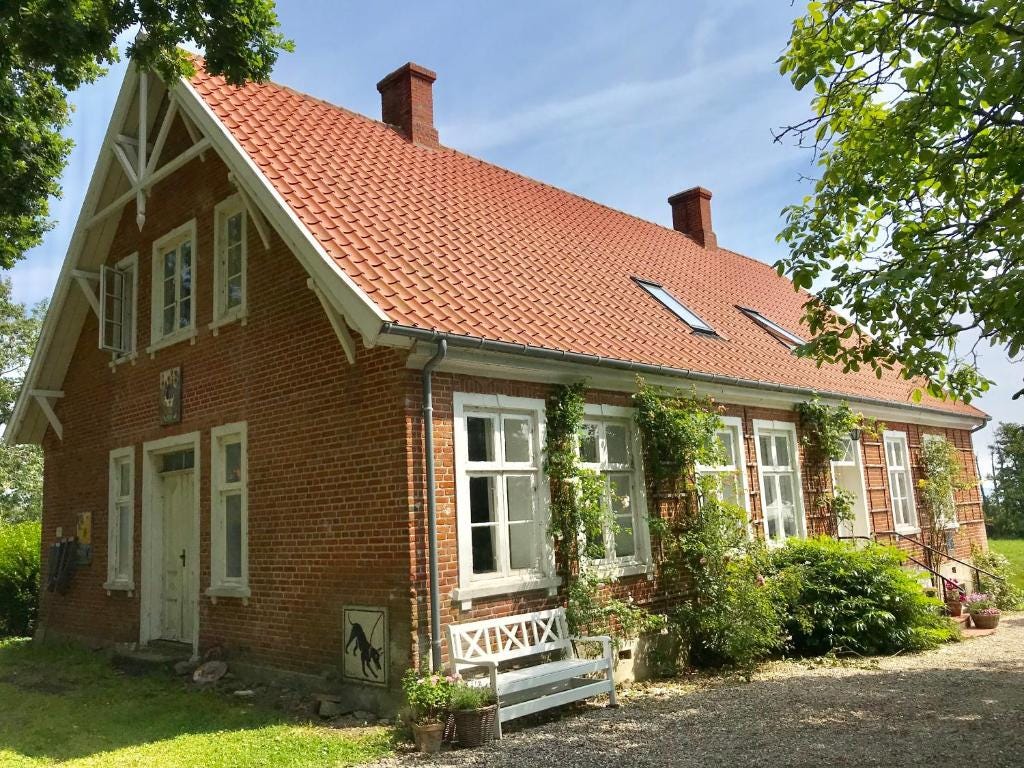
We were warmly welcomed into the cottage by an older lady who introduced herself simply as Elisabeth and the handsome teen boy with her as her great-nephew. As the son of the current baron, he was, of course a baron too. When I asked him about it, he shrugged and smiled. Krystle decreed that she would call him “Little Barron,” and she did. They flirted with each other while Elisabeth and my Danes got down to business of why I was there.
She was happy to hear my story about Gartner Hans Hansen, to see all of the photos. She kept interjecting, “Most amusing!” in a charming, posh British accent. Then she told us stories about the castle. She said, “It’s a shame my nephew was in Rome or I could have taken you through the old place.
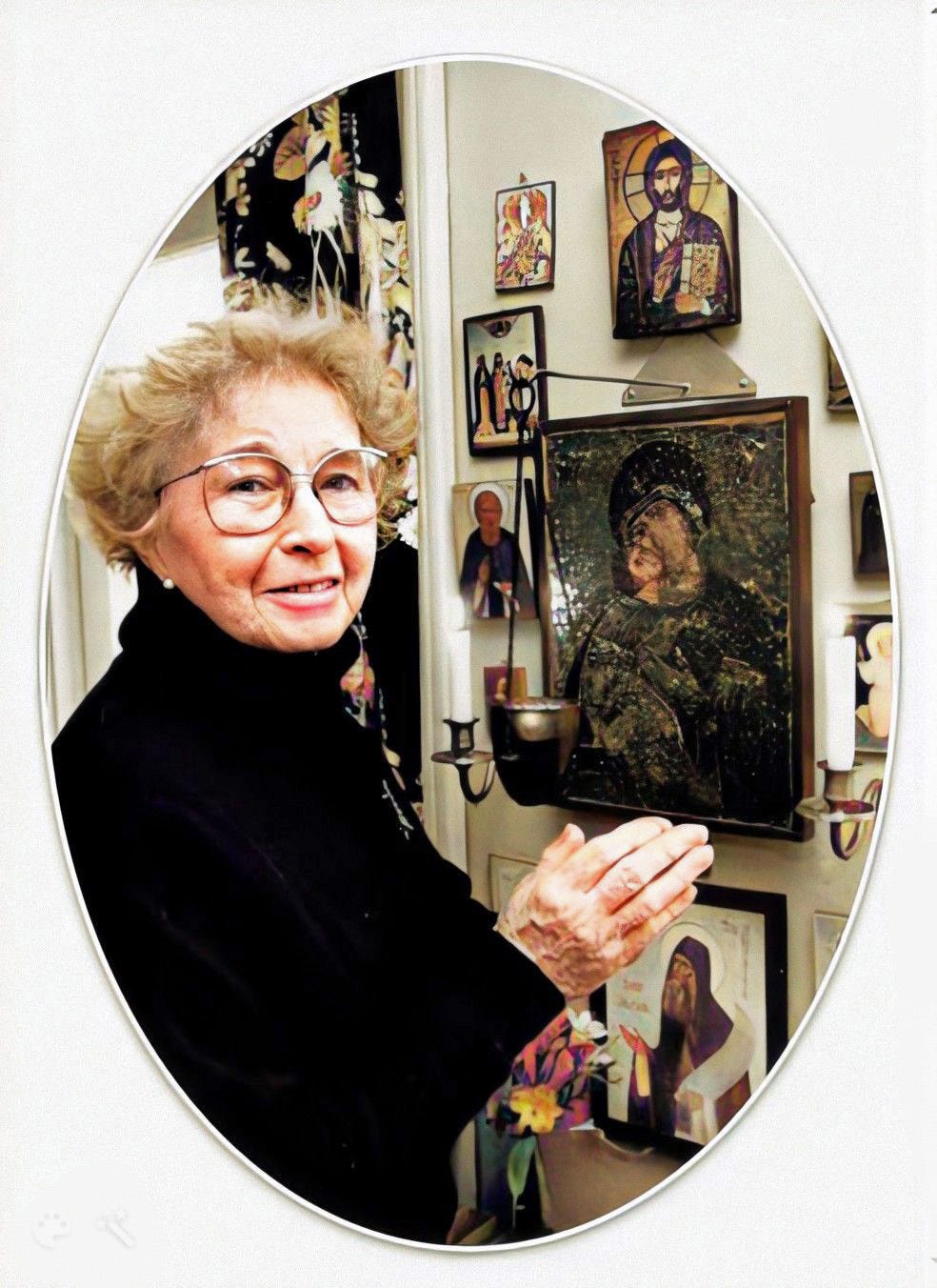
There was a question that had been smouldering in Grethe all day and she finally had her turn to ask it. “Are you any relation to the author Karen Blixen? she asked.
Elisabeth answered, “Mercy yes! She’s a relative. A good writer, but quite a witch,” she answered forcefully. “A witch with a B,” she added, nearly under her breath.
When she wasn’t more forthcoming on how she was related to Karen Blixen-Finecke, we thought that she was being discreet. Now I wonder if it’s because the Blixen-Finecke family tree is so twisted that it’s impossible for one to know without carrying around the 626 page The Manual of Rank and Nobility, or Key to the Peerage. I spent over ten hours researching the exact relationship and finally was too dizzy to care. Suffice it to say that they were several different layers of cousins once or twice or three times removed.
My three Danes were simply beside themselves with this news, but I was mystified. I had not heard of her. I learned that she was born Karen Dinesen (and sometimes wrote under the name Isak Dinesen) and married her second cousin Baron Bror von Blixen-Finecke from the Swedish side of the Blixen-Finecke dynasty, even though she had been in love with his twin Hans Gustaf von Blixen-Finecke. Now they knew that the graves they saw before church were from the famous family. We also learned that the blue ornate one with the mosaic was the one Elisabeth had made for Thorbjørn Møller, her second husband. She asked if we’d seen it, and we were pleased to say we had, but it was more meaningful since we met the artist. After we exchanged addresses, we tore the flirting young people away from each other, thanked Elisabeth profusely, and went our way, each of the five of us filled with the joy that only such a magical day can bring.
***Thirty Years Later***
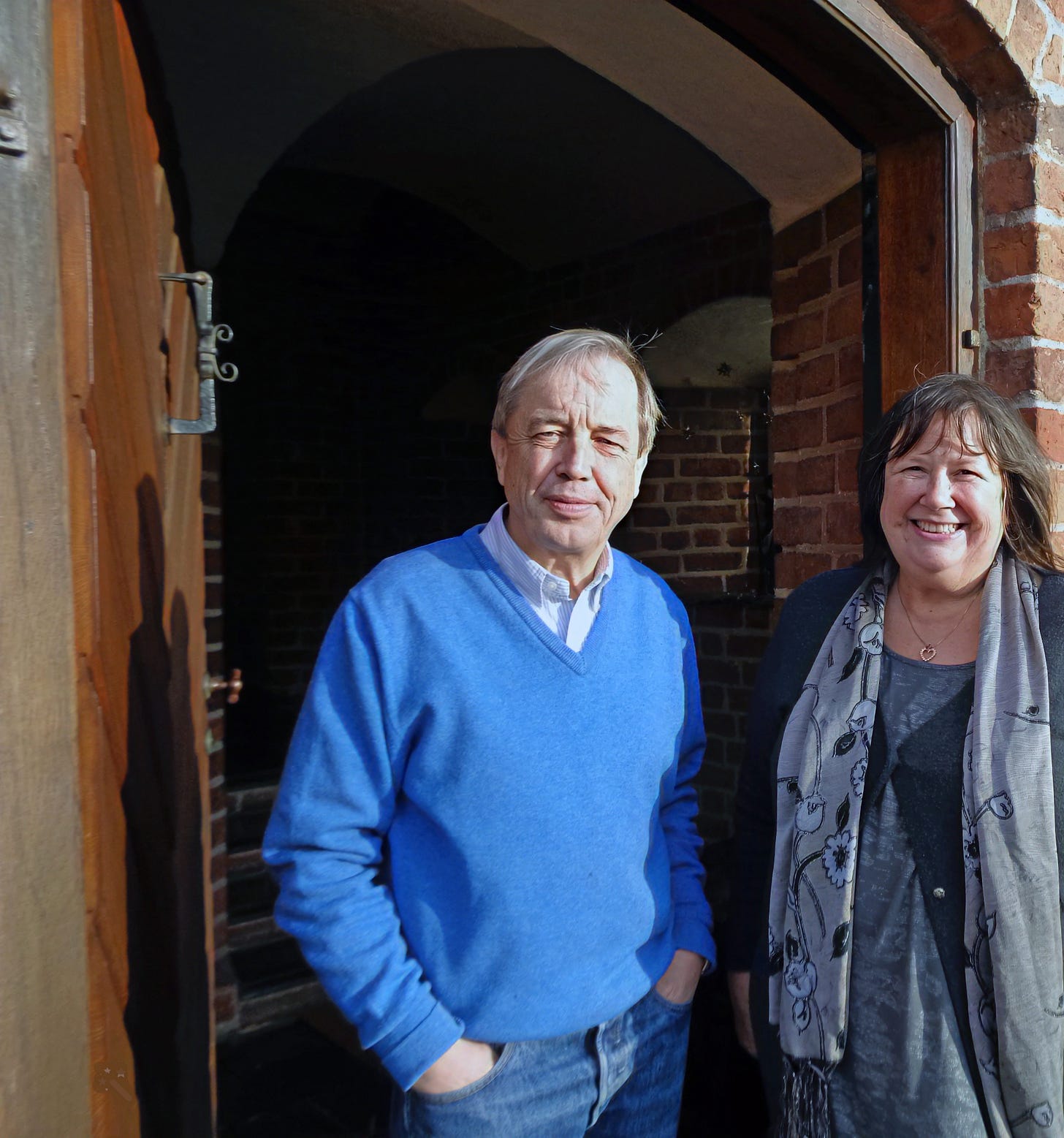
It was almost exactly 30 years from the time that Krystle, Mia, Grethe, Viebeke and I ventured into Hesselagergård uninvited and unannounced, before I saw it again. In those years, I continued my research looking for my grandmother’s childhood home and searching for my Danish family. By 2018, all of the mysteries had been solved, and my husband Craig Bjork and I were on a trip to visit my Hansen cousins in Nysted on the coast of the island of Lolland. They are the progeny of Hans Hansens brothers Jens and Rasmus and were gathering from all over the country to meet me. Rasmus Hansen’s grandsons Bernt and Jens took turns hosting us for incredible meals after putting us up in a lovely hotel.
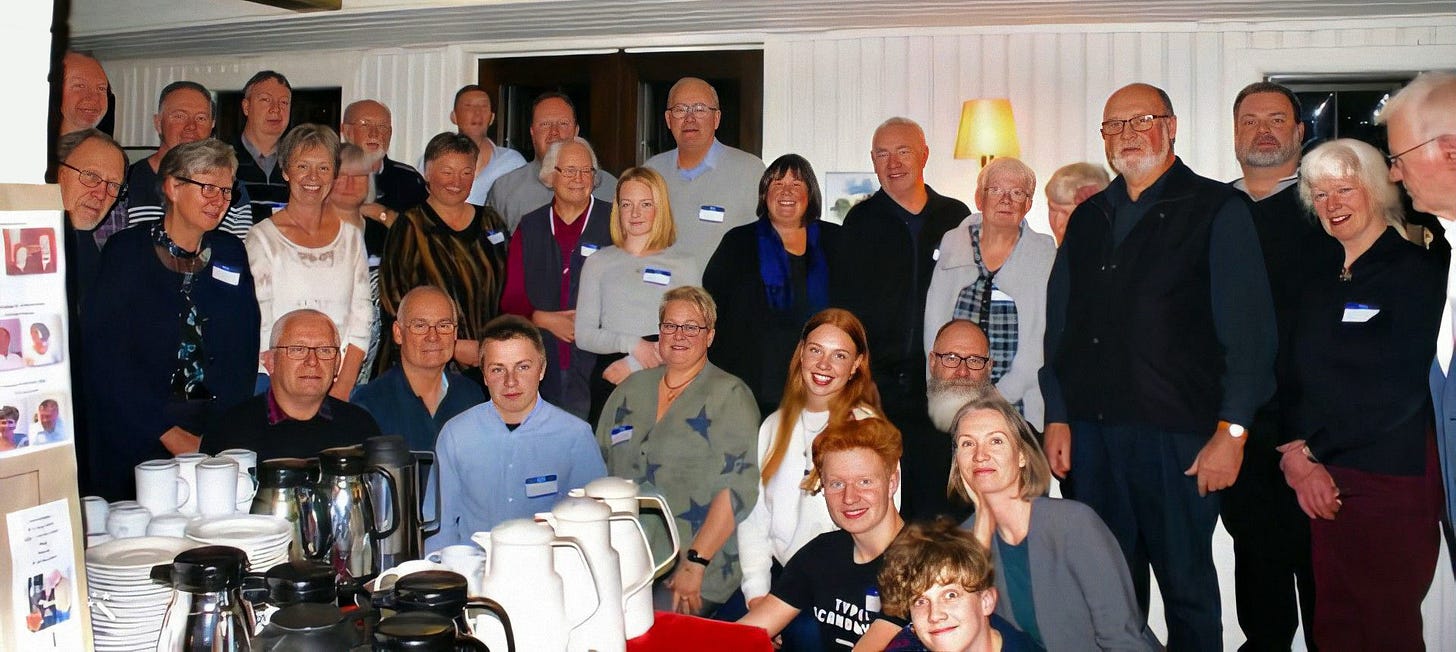
Arne, at the archives in Gudme has been a help over the years, doing searches for me for photos of my family. He found this one of Hans and his youngest brother Jens in a photo of those with skilled professions, (not servants) at the manor. The census tells us that 16 year old Jens was there as Hans’ apprentice, but he must not have taken to gardening as his older two brothers did: he married in Paris, moved to Copenhagen and became a carpenter.
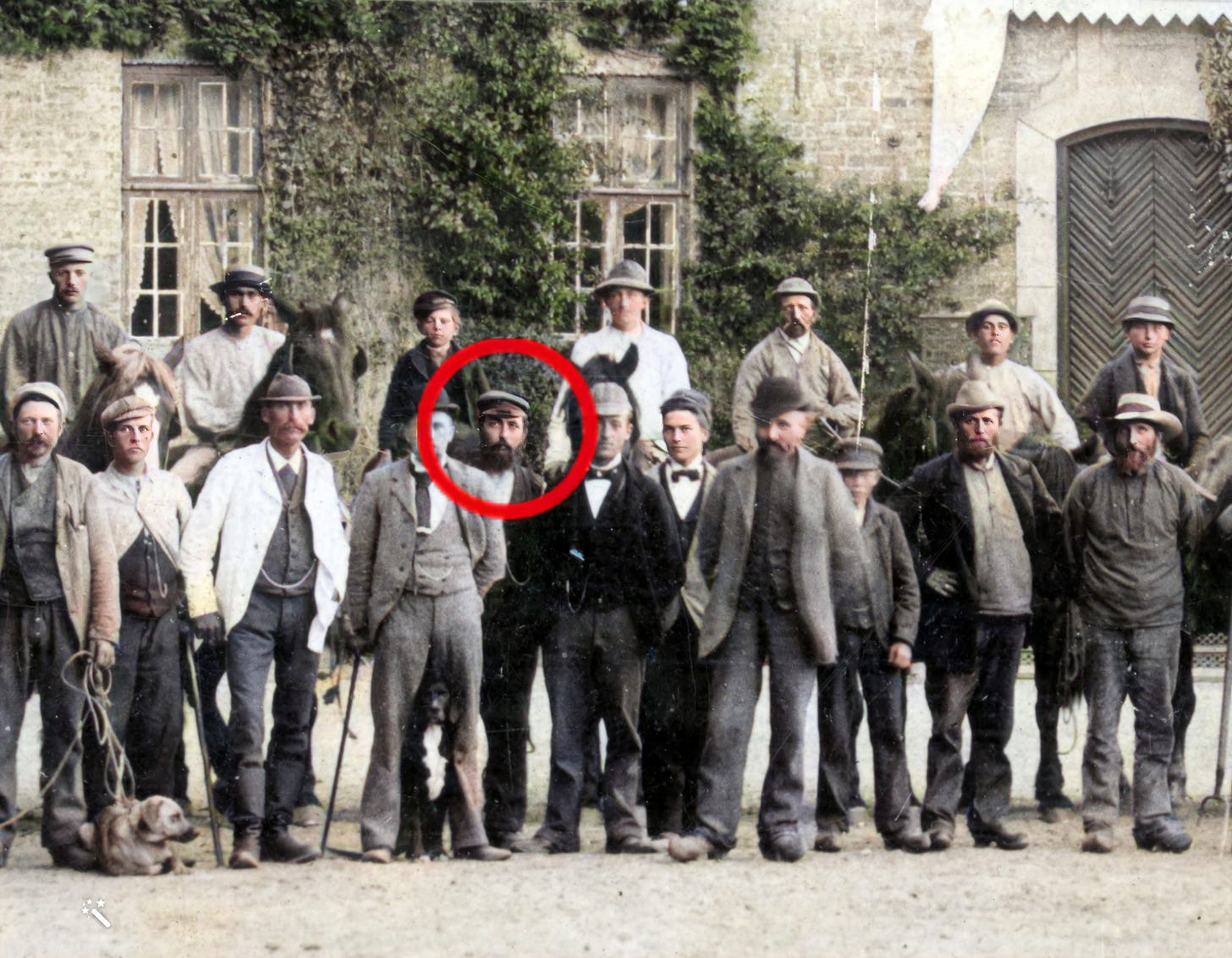
My second chance to see Hesselagergård was through my friend, Danish artist Mai-Britt Schultz who had a contact who was friends with the current baron. She was able to set up a visit on January 3, 2019 and, this time, we had an invitation, and the baron would be home. Sadly, our sweet Elisabeth had died in 2001.
The baron warmly greeted us at the door wearing jeans and a sweater and asking us to call him Henrik. I don’t know if I was expecting a powdered wig and knee breeches but what does an American know about the daily dress of European nobility? He was alone in the castle, so he was able to show us every bit of it, top to bottom.
To get from top to bottom of a castle there must be stairs and stairs there were. They were everywhere. We couldn’t walk a few feet without being confronted with another staircase. This, I suppose, is how the occupants of the manor house, Henrik and his two adult children, keep in shape. We started the tour in the attic and worked our way down to the basement, so we met every stair in the place.
Our first stop was what I called the attic because of the odds and ends of (very old and valuable) castoff furniture up there. However, Henrik explained that this section of the castle was built for defense. At the very top of the building, there’s a defensive corridor—complete with machicolations (overhanging openings) designed for dropping projectiles or boiling liquids. As I took a photo of it, I told Henrik I was very glad they didn’t use it on Krystle, Mia and me when we were storming the castle gates in 1998. This passage is as much a structural feature as it is a medieval "room" of sorts, integral to the fortress-like nature of the house. Built in the middle ages, the boards were held together with wooden plugs. From the small windows from which arrows could be shot, I could see the Gardener’s House where Hans and Emma lived.
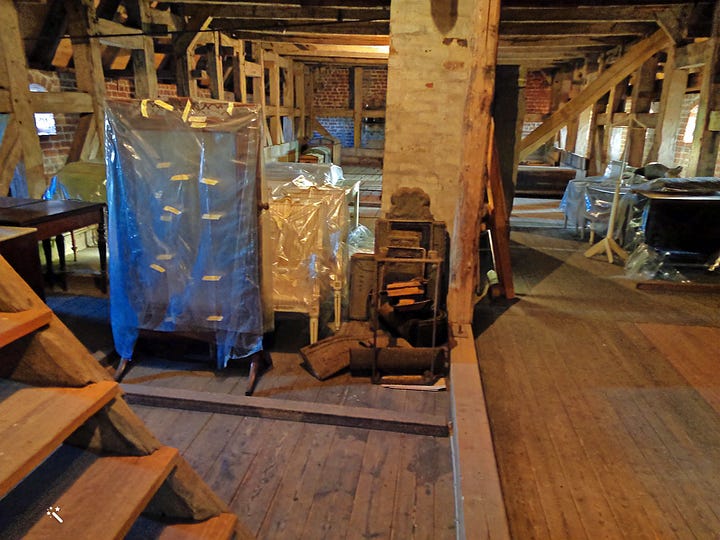
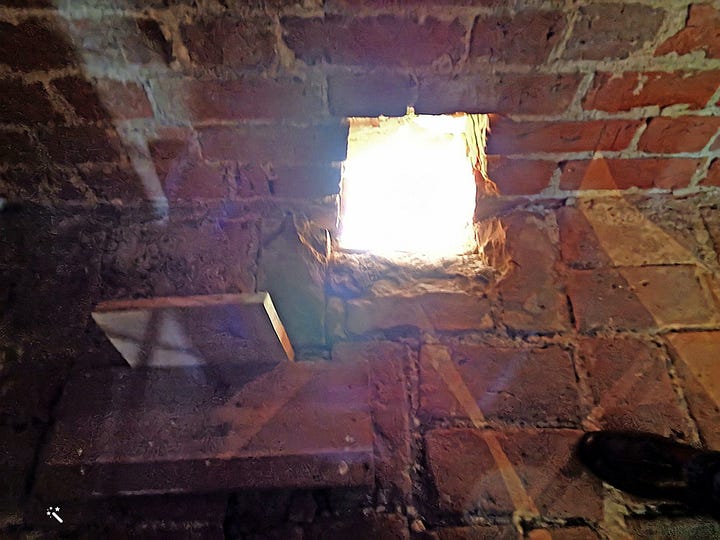
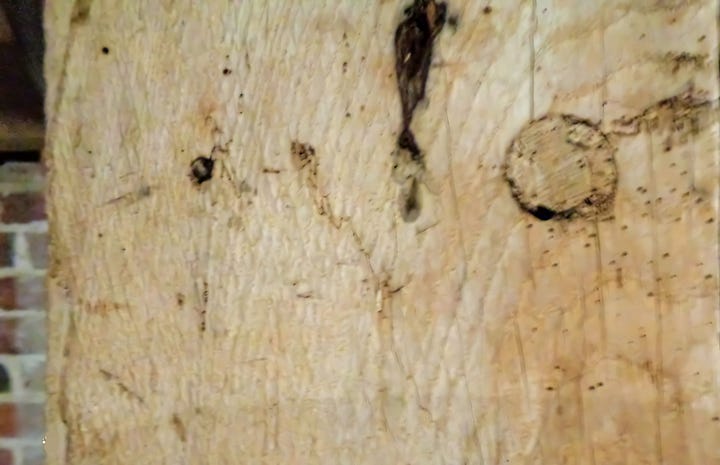
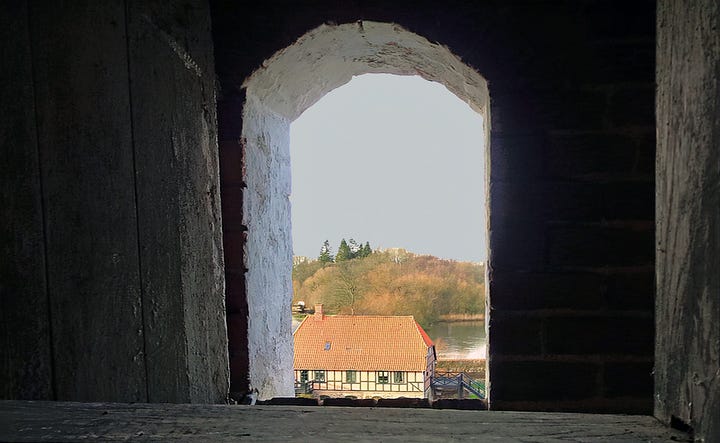
The next floor down was the private floor of the family and I was flabbergasted that he shared those rooms with us, including his bathroom and bedroom. He approved me taking photos. I respectfully didn’t take pictures of the kids’ rooms because they were untidy.
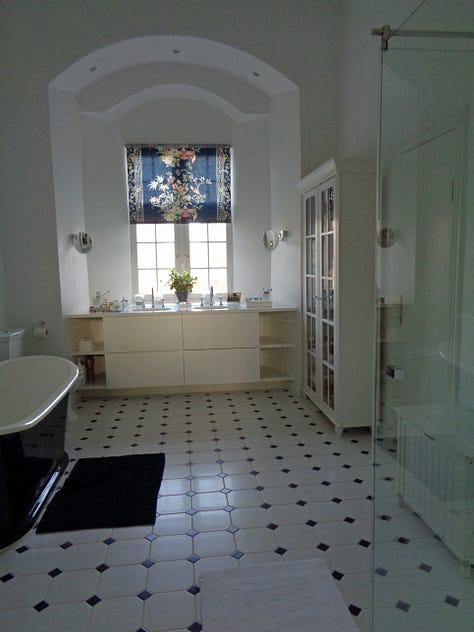
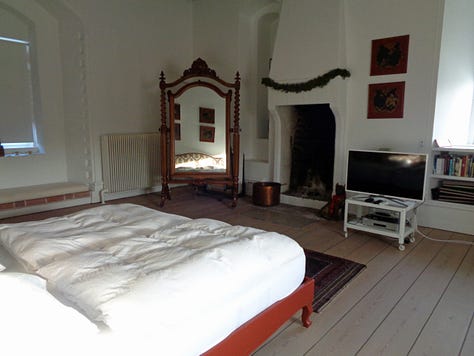
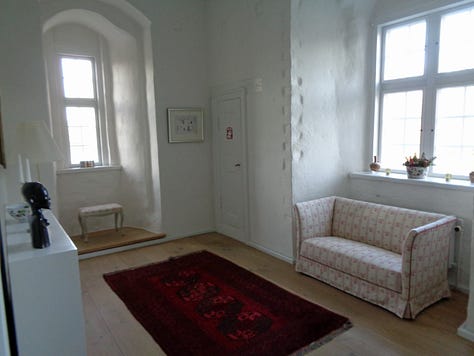
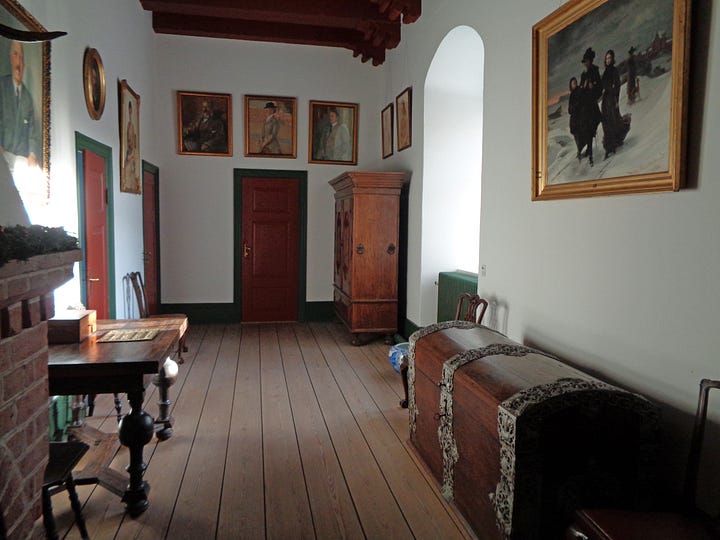
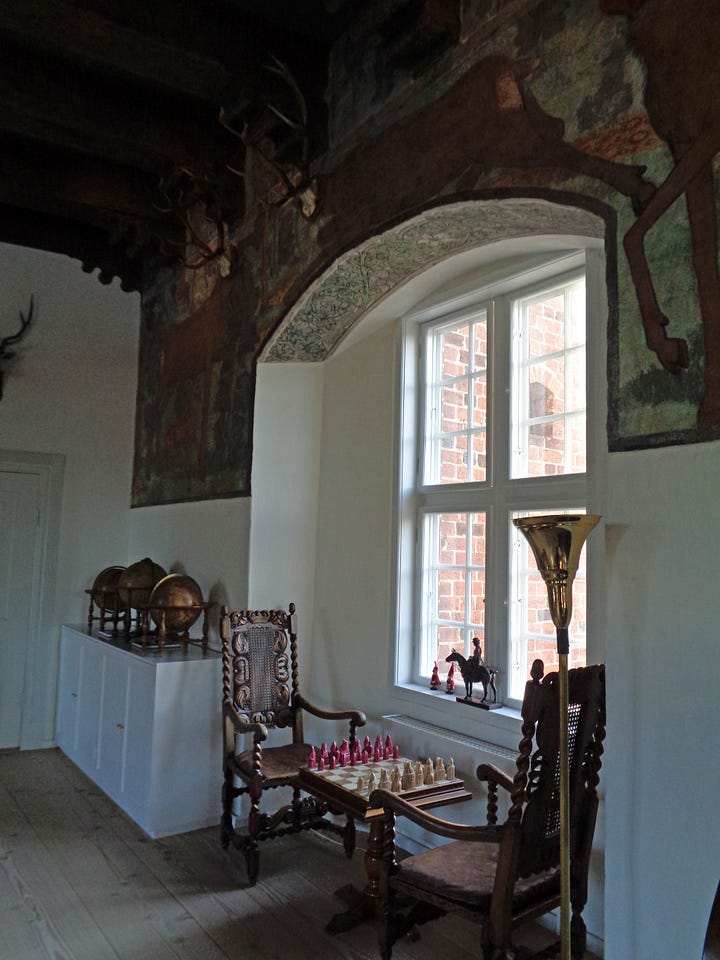
The photo below is very meaningful to me. It is the view of the Gardner’s House, my great-grandfather’s house, from the inside of the castle. I’ll bet he never thought that one day his great-granddaughter would be looking down from there.
On the ground floor, the main room is the “Deer Hall” (Hjortesalen). This magnificent room is what Hesselagergård is most famous for. These friezes of hunting scenes were painted about 1550. The Renaissance fresco includes stylized deer, hunters, and hounds, possibly painted by German artisans. This room, with it masculine virility, was appropriate for formal gatherings of male landowners.
The government (Slots- og Kulturstyrelsen, the Danish Agency for Culture and Palaces) pays the family to keep the manor house going, partially due to the high value and rarity of these friezes and the fact that it is the oldest Renaissance building in Denmark. They also get a break on property taxes. The funding is only for areas of the house that are of cultural or historical significance. Modernization or updating of the family quarters is their responsibility.
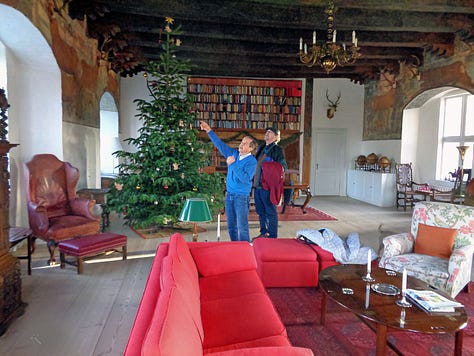
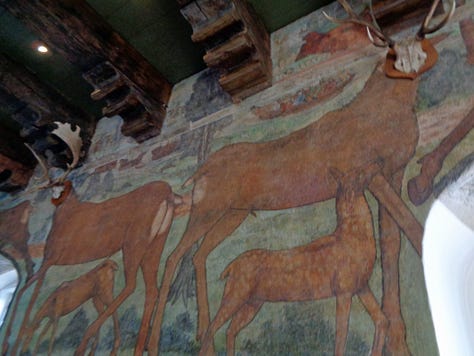
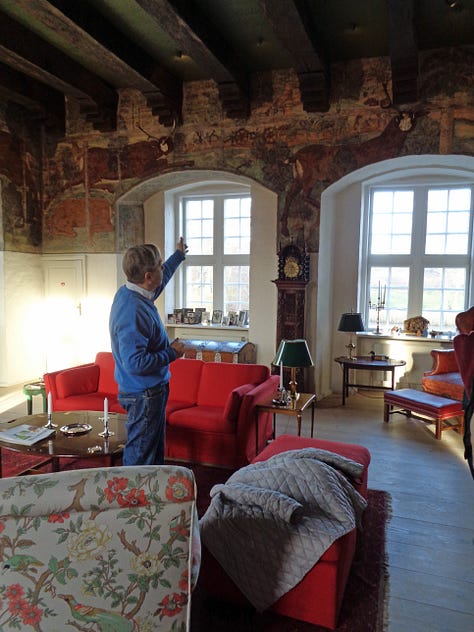

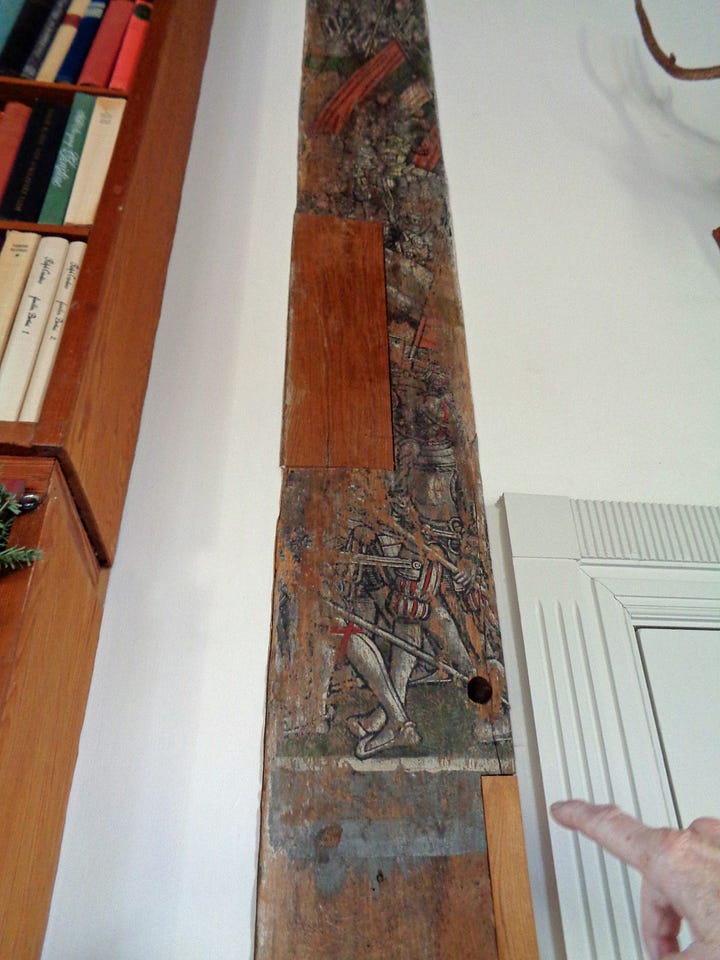
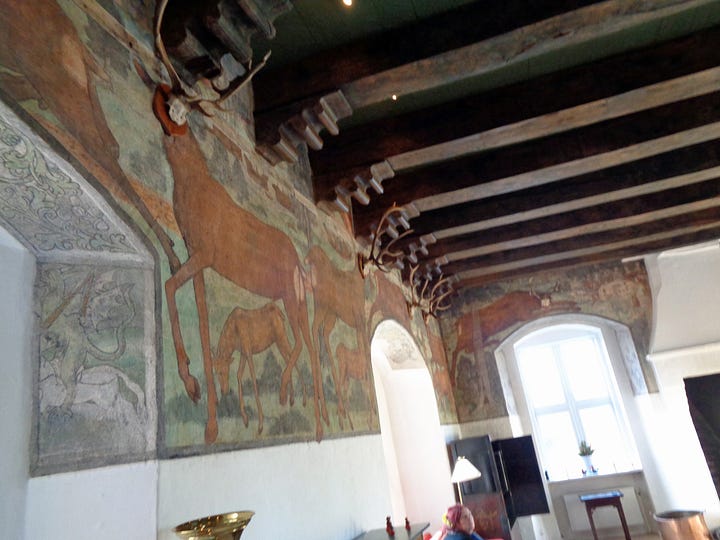
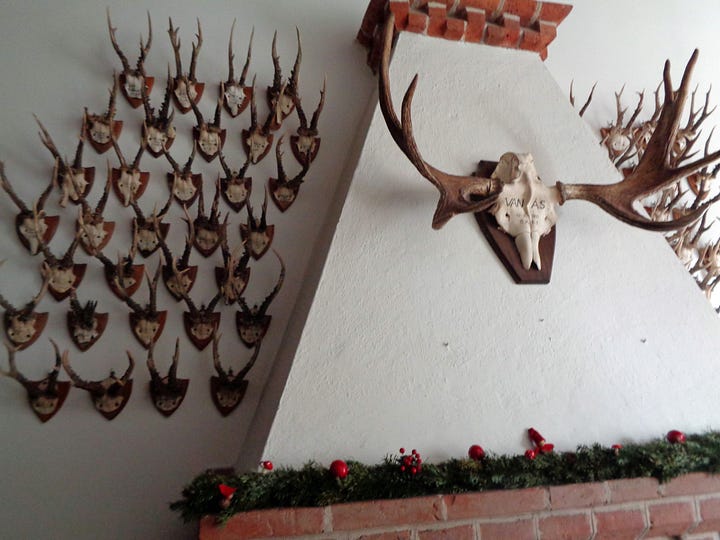
This is Princess Auguste Sophie Friederike Marie Caroline Julie (Augusta) of Hesse-Kassel 1823-1889. She is Henrik’s great-grandmother. Her royal parents were Prince William and Princess Charlotte of Denmark. She married Carl Frederik Axel Bror Baron von Blixen-Finecke, which was a scandal, since he was married with two children when they met and fell in love. In addition, he was much lower in rank being only of nobility, not royalty. Their marriage joined the Blixen-Fineckes with European royalty. Our Baroness Elisabeth of the magical afternoon, is also technically a princess. Again, I tried to get a untangled family tree chart for the Blixen-Fineckes, but they are so convoluted it looks like a dropped bowl of spaghetti, and I can’t make sense of it.
This was my favorite room. I call it the Green Salon, but I’m sure it has its own name. In contrast to the masculine Deer Room, this is dainty and feminine. I can imagine that this is where the ladies gathered while the men were in the Deer Room. It is not as daunting as some of the other big rooms and halls. I can see reading a book or chatting with friends here. When we were touring the family's floor with all the the long halls and huge furniture and paintings, I said something I regret now. I said, "It's not very cozy." He disagreed, saying, "Oh, it is cozy! We are very comfortable here." I believe that feeling cozy in a place comes from familiarity. While I never could feel the coziness of the rest of the baron’s home, this room did feel cozy.
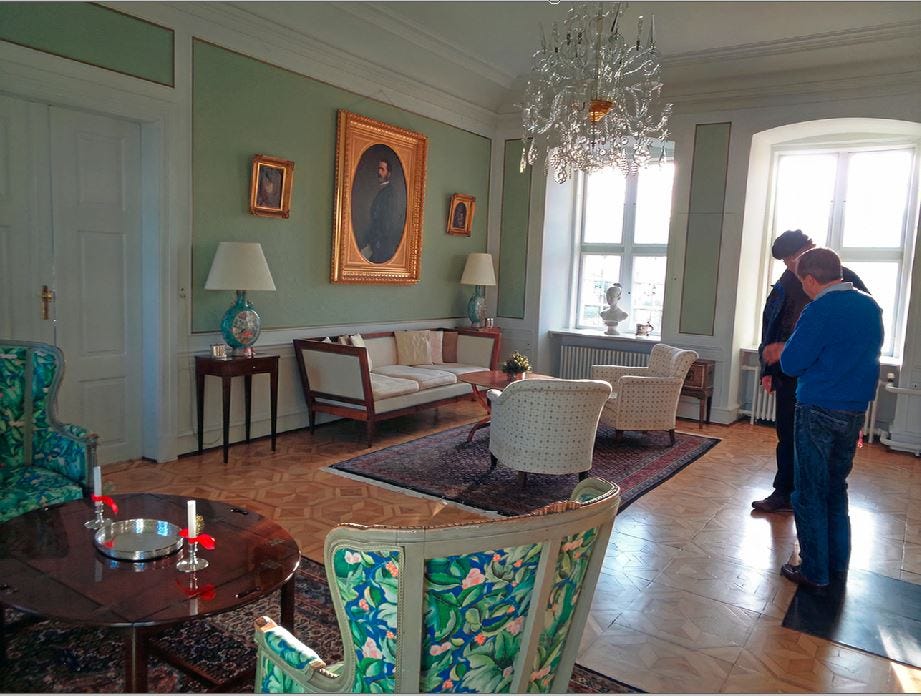
Ancient nobles and royals were looking down at us from everywhere, wondering what the gardener’s granddaughter was doing running around the manor. It strange and wonderful to know that Elisabeth was one of the nobles and royals. The second to the last picture is of her and her husband and the last photo is of her. I know she would be thrilled to know we finally made it through a tour of “the old place.”
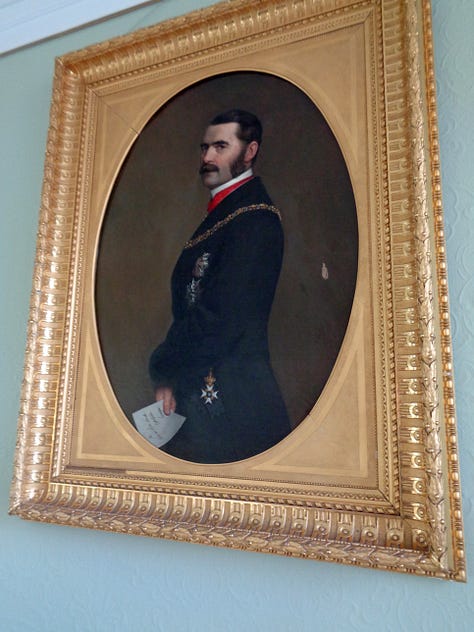
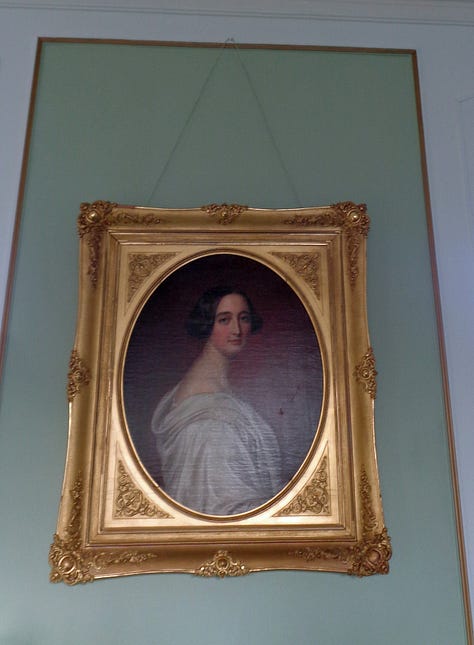
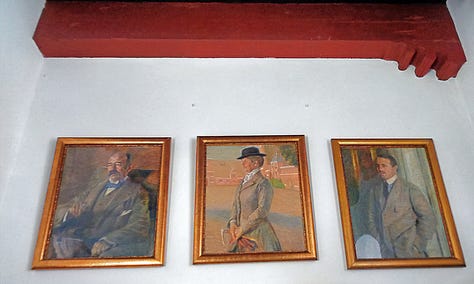
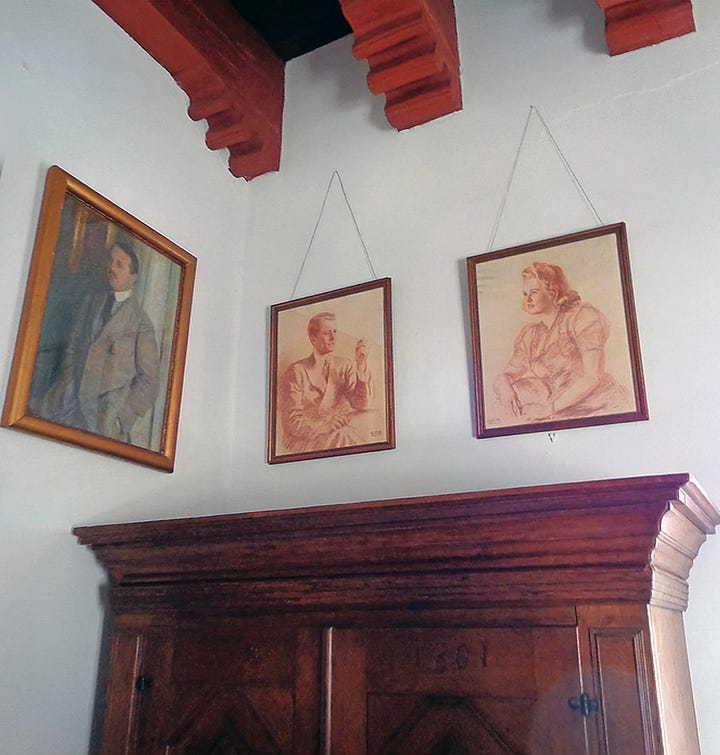
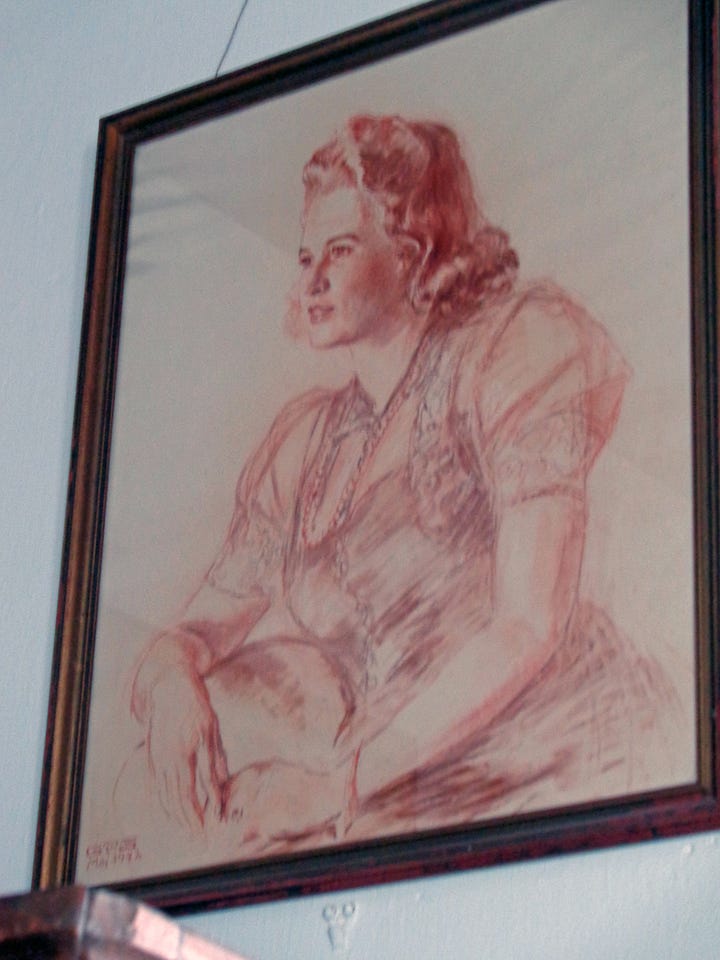
This strange rendering was in a hallway. It was uncovered under some plaster and doesn't match any of the other paintings in quality or subject manner. Henrik and I were joking that they let some kid do a painting while the deer and hunting scenes were being done. You know how kids always run out of paper on one end? The one ran out of castle.
As we worked our way down all of the floors, we found the room Mia, Krystle and I had glimpsed through the windows when we crashed the castle gates: the kitchen. For a basement kitchen, it was incredibly bright and modern. I asked Henrik if I could please be his chef and he smiled at the idea, but said he does most of his own cooking these days. I still dream of it sometimes. Maybe we could even live in my great-grandfather’s house.
This usual bathroom is off the kitchen. Henrik said it was once the room for drawing fresh water and for baking bread. The fieldstones visible in the walls may be were part of the medieval structure. I respect the baron for preserving this history, while making things pleasant and convenient for those here in the present.
We started in the attic and were now in the basement, so I thought our tour was over, but it was not. Incredibly there was one more floor beneath us. To reach it, we had to bend at the waist and squeeze through a ridiculously tiny door to what Henrik told us was the jail, part of the original 1500s stronghold. You can see the “potty,” a small window high in the wall, and, incongruously, a mannequin of Johan Friis, the builder of Hesselagergård in full medieval costume. “Goodness!” I exclaimed. “Someone’s in jail!” Henrik looked quizzically at the figure and said, “That’s Johan Friis, the owner who had this re-built in 1538. I’ve no idea what old Friis is doing down here.”
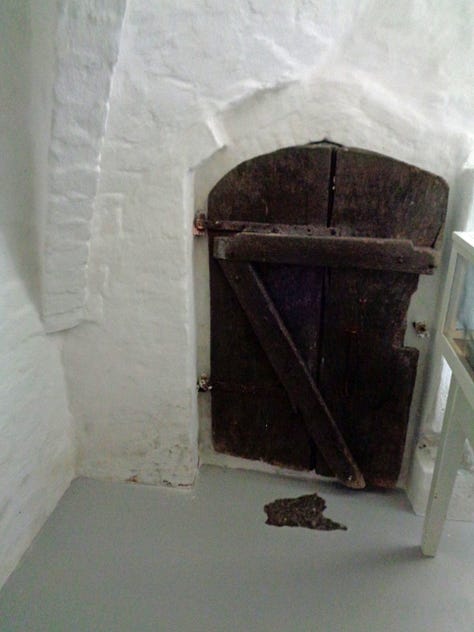
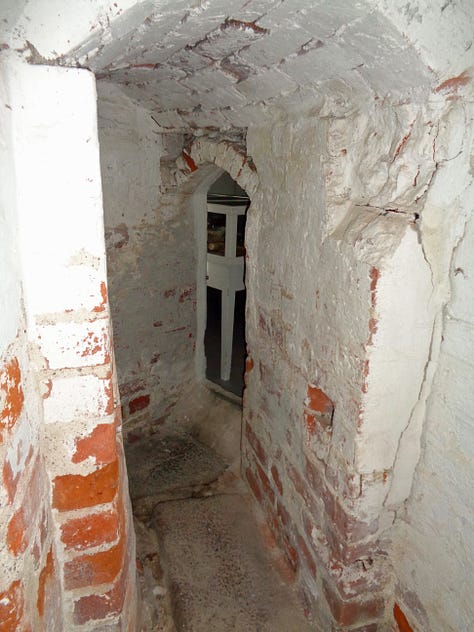
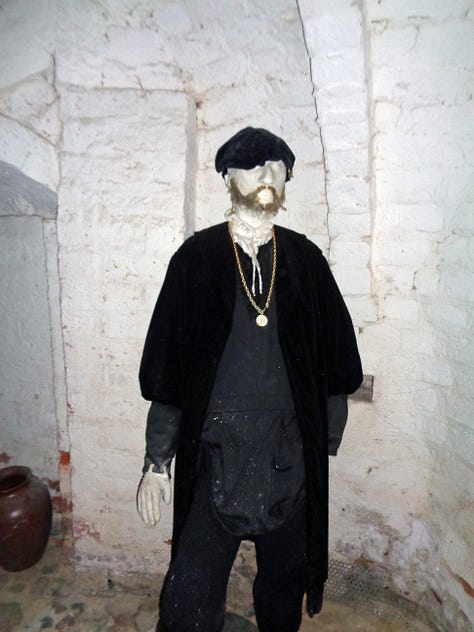
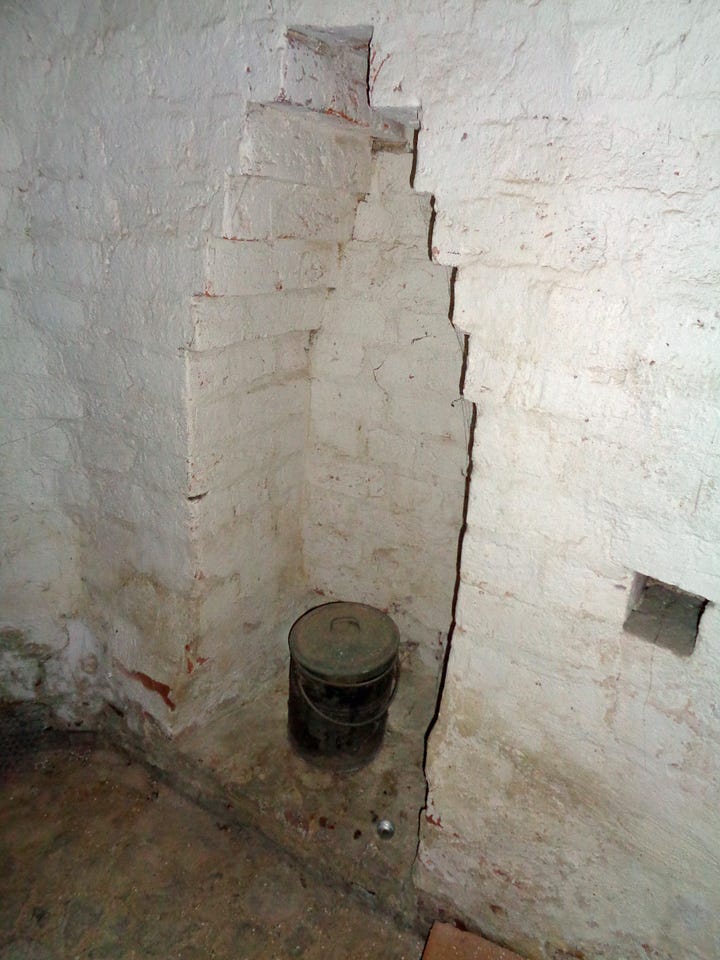
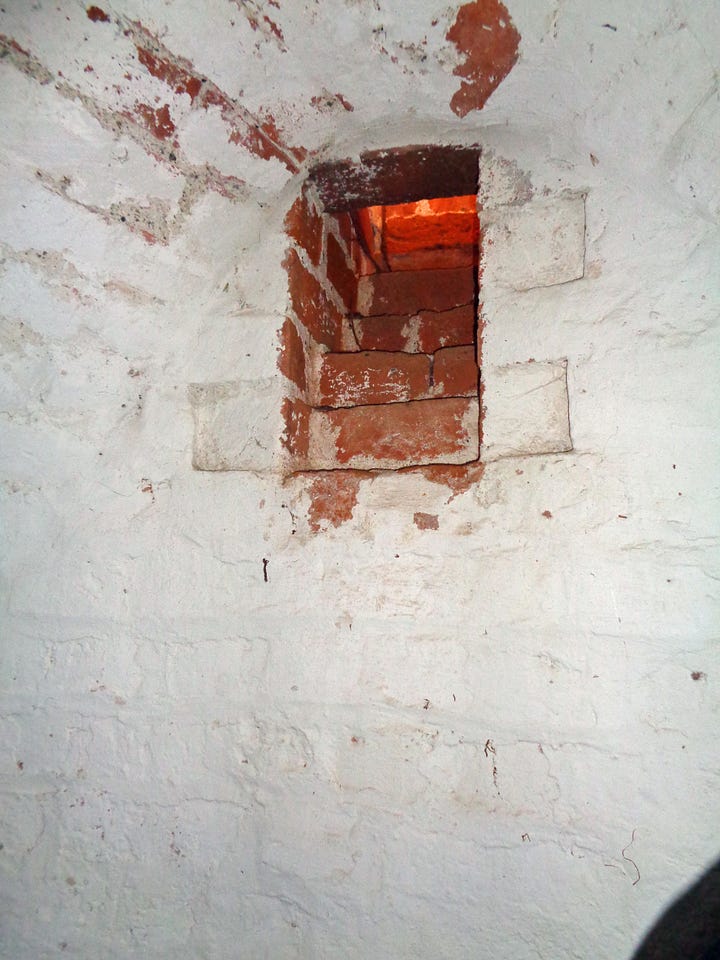
I want to leave my readers with this photo of the aftermath of the New Year’s Party, a poignant example of both nobility of normality and glitter among garbage. To me, it represented the fantasy—born of too many episodes of “Downton Abbey”—and the reality of modern European nobility. We arrived on January 3rd, before the maids had reset the room, a thing Mr. Carson would never let happen. But unlike “Downton Abbey,” Hesselagergård doesn’t have a full retinue of servants. The maids are more likely to be local women who could make it in to clean after their own holiday revels. Whenever I feel like I’m just not keeping up, I think of napkins on the manor house floor and remember we’re all just people.
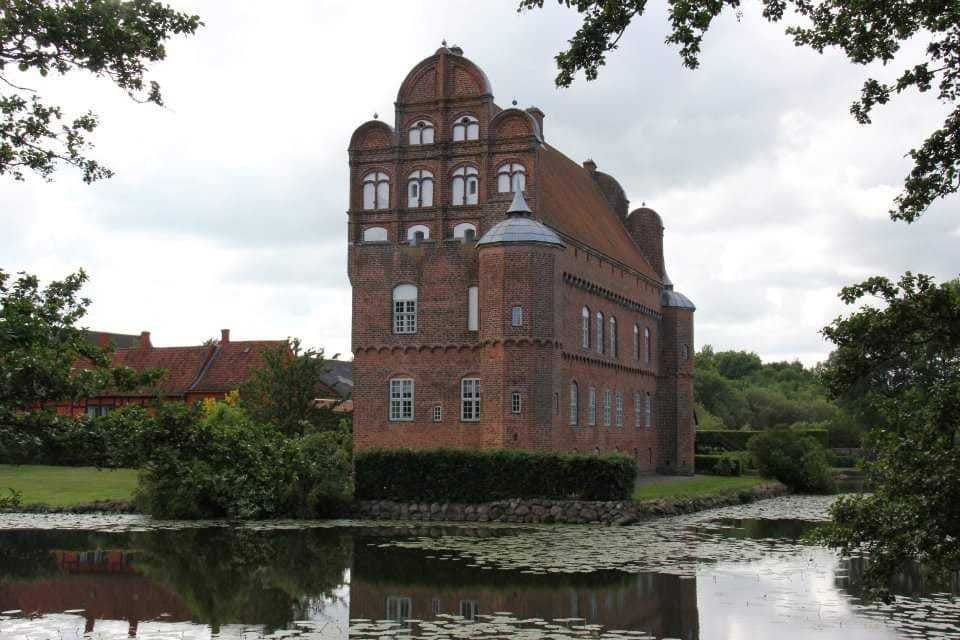





























What a terrific home! I love the deer hall and kitchen!
How fantastic! This is a riveting story. Thanks so much for sharing your family history and past adventures! Isn't it amazing how we are all woven together through time and across generations and socioeconomic variances? What an amazing tapestry this human experience is!